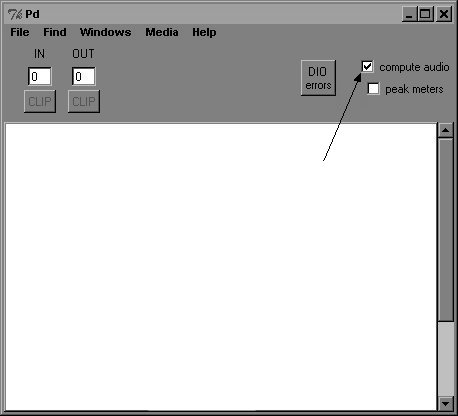3.1 Basics
3.1.1 Pitch
Let's return to our first example. You heard a tone with a frequency of 440 Hertz (later with other frequencies, other pitches). You could turn it on and off - i.e., adjust the dynamic from loud to inaudibly quiet.
About pitch: Pd works with two kinds of pitches - Hertz or MIDI numbers. The traditional signs: A, B-flat, G-sharp, etc. are not used at all in Pd. Instead all chromatic pitches have MIDI numbers: A4 is the number 69, B-flat4 is 70, etc. The other way to describe pitch in Pd is in Hertz. To understand this, we need to understand a bit about musical acoustics.
피치에 대해서 피디는 두가지 종류의 피치로 작동한다. 헤르츠와 미디넘버
A4 의 미디 넘버는 69 Bflat 4 는 70 로 표기한다.
3.1.1.1 Theory
3.1.1.1.1 Controlling speakers digitally
Sound is air in vibration. Traditional instruments are used to vibrate air at specific frequencies. You can do this, e.g., with strings (violin), lips (trumpet), or membranes (timpani). We even have a membrane in our ears - the eardrum - that vibrates sympathetically with vibrations in the air. Our brain transforms these vibrations into a different form, which is what we would call sound.
In electronic music, we use speakers to generate sound. These also have a membrane (or several) that vibrates back and forth, which causes the air to vibrate.
소리는 진동, 전통적으로 악기는 특정 프리퀀시에 맞는 공기의 진동을 만드는 것인데,
전자음악은 스피커로 소리를 발생시킨다 막이 있는데 그 막을 앞뒤로 떨리게 해서... 공기를 진동시켜 소리를 발생

The vibrations of this membrane are controlled by the computer. In Pd, the "dac~" object (digital audio converter) handles this. Here's how it works: sound is a physical phenomenon - vibrations in the air to be precise - and, as such, it is analog.Computers, however, work only with numbers, which means they are digital. The "dac~" object turns numbers into sound by converting numbers into fluctuations of electrical current that - once amplified - cause the speaker membrane(s) to vibrate accordingly.
그 막의 진동을 컴퓨터 피디에서 콘트롤하는데, dac~ 오브젝트는 (digital audio converter)가 그 역할을 수행한다. 소리는 물리적 현상이고, 공기의 진동은 아날로그 정밀하고 아날로그다. 컴퓨터는 오직 숫자로만 움직이고, 디지털, dac~ 오브젝트는 숫자를 소리로 변환시켜주고 숫자를 전류의 파동으로 변환시킨다.
 |
|---|
The reverse of the this process would be to connect a microphone to a computer. A microphone also has a membrane that responds to vibrations in the air and converts these vibrations into fluctuations in electric current, which it sends to the computer where they are then converted into numbers. In Pd, this input can be received with the "adc~" object.
이 프로세스의 반대가 컴퓨터에 마이크를 연결하는 거다. 마이크도 공기의 진동에 반응하는 막을 가지고 있는데, 이 진동을 전류의 파동으로 바꾼다. 그리고 컴퓨터로 보내고, 숫자로 바꾼다. 피디에서 adc~ 오브젝트가 마이크 인풋이다.
 |
|---|
Let's go back to speakers for a moment. A speaker's membrane can move back and forth. The outermost position (the most convex) is understood by the computer as position 1. The innermost position (the most concave) is position -1. When the membrane is precisely in the middle, as when at rest, this is position 0. All other positions are values of between -1 and 1.
 |
|---|
In reality, these movements are so small and so fast that they almost cannot be observed with the naked eye.
스피커로 다시 돌아가서 스피커 막이 제일 불룩 튀어나왔을때 컴퓨터 세계에서 1 의 위치라고 이해하고 가장 안으로 굽어 들어와 있을때 -1 이라고 컴퓨터가 이해하고, 스피커 막이 중간에 놓여져있을때 0이라고 이해한다.
그래서 볼륨 값들이 -1에서 1사이 로 이해하면된다
현실에서 이러한 운동들이 너무 작고 빨라서 우리가 관찰할수조차 없다.
3.1.1.1.2 Waves
Let's imagine that a membrane moves from one extreme limit to the next (most convex, most concave) at a constant tempo:

Let's mark the individual stages:

In an abstracted form with membrane position on the y-axis and time on the x-axis, we could represent such motion like this:
스피커 막의 가장 중간부분들을 이어서 선으로 만들면 이렇다.


In physics terminology, this is called awave. Here you can clearly see thewave form- a triangle.
There are different waveforms for different kinds of membrane movement. Their names reflect their visual resemblance
지금 그려진 형태를 전문용어로 웨이브, 트라이앵글 웨이브 폼이라고 한다.
다른형태의 스피커 막 운동으로 형성되는 다른 형태의 웨이브폼 들이 있다.
이름이 다 시각적 닮음을 반영한다:

The Pd object "osc~" creates a sine wave.
One important thing to remember with regard to waveforms: they repeat constantly without changing their motion characteristics. Vibrations that exhibit this quality are said to beperiodic. A period is one complete cycle of a vibration that constantly repeats.
피디에서 osc 사인웨이브를 만들면, 중요한것이, 그것들이 계속해서 그들의 운동변화없이 계속 반복된다는거
진동은 주기적이고, 그 주기는 끊임없이 반복되는 하나의 완전한 진동사이클로 이루어진다는거

What makes periodic vibrations special is that we hear them as clear tones with definite pitch. In contrast, noises are aperiodic vibrations.
주기적인 진동의 특이한점이 우리가 분명한 피치가 정의된 분명한 톤을 들을 수 있다는 거, 반면 노이즈는 비주기적인 진동이다.

3.1.1.3.2 DSP
It has become clear that simultaneous processing of numerous signals is very taxing on the computer. Imagine working with 100 "osc~" objects. Each one generates 44100 numbers per second and these have to be synchronized with each other. That's why Pd offers you the option of turning offDSP(digital signal processing) in the main window. This will spare your processor unnecessary work.
100개의 오실레이터가 한꺼번에 1초에 44100숫자를 제너레이트 하고 서로 싱크 맞추고 있으면 컴퓨터가 얼마나 힘들까. 그래서 offDSP(digital signal processing)이라는 스위치를 달아놨다.

You can also send this as a command; the recipient "pd" is in this case the program itself:
피디패치 안에서 이 명령어를 만들어서 dsp를 제어 할 수 있다.

With regard to computer music, the faster the processor, the higher the performance.
Pd lightens its workload by working with samples in blocks rather than individually. This greatly improves performance. The standard block size is 64 samples, but this setting can be changed. More on this at3.8.1.1